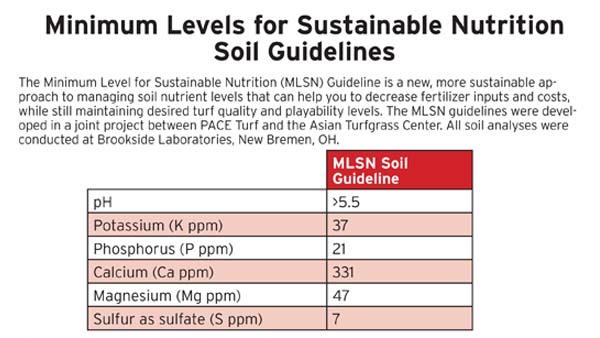 The numbers 94, 39, 50, 88 and 96 are not this week's winning lottery numbers. Instead, they represent a much safer bet.
The numbers 94, 39, 50, 88 and 96 are not this week's winning lottery numbers. Instead, they represent a much safer bet.The numbers represent the percentage of Global Soil Survey participants whose potassium (94 percent), phosphorus (39 percent), calcium (50 percent), magnesium (88 percent) and sulfur (96 percent) inputs fell below the levels proposed in conventional soil nutrient guidelines for turf. The survey shows they saved money and increased environmental sustainability without compromising turf quality.
The Global Soil Survey for Sustainable Turf is a collaborative effort of turf managers and researchers whose goal is to refine nutrient guidelines so that turf managers can apply precisely the nutrients the turf needs. To accomplish that goal, turf managers from around the world joined the survey and collected soil samples of healthy turf and submitted them for analysis in 2013. The results were evaluated by scientists at the Asian Turfgrass Center and PACE Turf, who compared them against both conventional soil guidelines, as well as against the newly developed Minimum Levels for Sustainable Nutrition guidelines.
"The first year of results from the Global Soil Survey (GSS) have broken new ground," said Larry Stowell, Ph.D., of PACE Turf. "The data shows that good-performing turf can be produced at nutrient levels much lower than conventional guidelines suggest."
Stowell said the survey data have been added to the database of thousands of soil samples that were used to create the MLSN guidelines.
"The addition of the Global Soil Survey data to the large database that derives MLSN makes us even more confident that the MLSN guidelines are robust and can be used successfully under a wide variety of conditions, said Micah Woods, Ph.D., of the Asian Turfgrass Center. "We are also very proud that the survey is an open science project. In other words, we don?t only share the charts, tables and reports with the public, but we also share the underlying data analysis scripts and code involved. This allows anyone who is interested to check out what we have done, how we have done it, or to even to use the data for their own purposes."
The Global Soil Survey will continue to run for at least another year.
"Our current conclusions are based on almost 4,000 soil samples from good performing turf, but we hope to increase the number of samples even more with the help of additional Global Soil Survey participants," Stowell said. "We will constantly improve the MLSN guidelines based on the data we receive."
The Global Soil Survey will continue soliciting turf manager participants for the foreseeable future. Soil survey participants receive a kit that contains all of the materials needed to package and ship three soil samples from their facility. The samples will be analyzed by Brookside Laboratories, and the data will be interpreted by Woods and Stowell.
"Each person receives a full report on their results, as well as an analysis of where each of their nutrients falls on the sustainability index," Woods said. "Turf managers have found the index to be really useful, because it gives them a numerical way to monitor where they are now and to track how they are improving over time."
- Gilliam and Associates and PACE Turf

